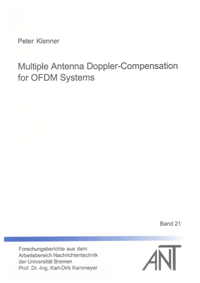
Shop : Details
Shop
Details

Peter Klenner
Multiple Antenna Doppler-Compensation for OFDM Systems
The pursuit of high data-rates for users moving with high speeds puts a lot of strain on the underlying data network. Nowadays, OFDM is an established method to overcome the channel’s frequency selectivity which is caused by the high signalling rate. It transmitts data in narrow frequency bands which are mutually orthogonal. This on the one hand defuses the equalization problem, but on the other hand it causes a prolonged symbol duration. However, the time selectivity of the channel, which is caused by the Doppler effect, leads to a loss of the frequency bands’ orthogonality.
This work is concerned with reliable high-rate OFDM data communication between a stationary transmitter and a highly mobile receiver. The key issue is the employment of multiple antennas at the receiver to compensate rapid channel fluctuations caused by the Doppler effect. To this end, known as well as novel techniques based on a uniform linear antenna array are presented and discussed. Those methods, on the one hand, exploit the relationship between angle of incidence and Doppler shift of impinging waves, such that limiting the range of incidence angles leads to a reduction of time selectivity. On the other hand, the correlation between the received signals of all antennas can be exploited to generate seemingly non-moving antennas.
From the essential theory of MIMO systems certain figures of merit emerge, which allow to dimension the linear antenna array and the consecutive signal processing. Furthermore, the problem of combining the task of Doppler spread compensation and MIMO communication is addressed. Here, the well-known BLAST scheme to increase the data rate and the Alamouti space-time code to increase transmit diversity are considered. Moreover, the tradeoff of spatial diversity for the ability of efficient Doppler spread compensation is discussed. It is shown, that based on a linear antenna array a reduction of the channel’s time selectivity can be achieved to allow for reliable data transmission even with high-level modulation alphabets and extreme speed of the user.
In addition, the problem of synchronization in time and frequency with respect to rapid channel variations is considered. A novel heuristic is derived from a well-known Maximum-Likelihood approach, which allows bandwidth-efficient and reliable synchronisation.
To compare and assess the performance of all methods a receiver with widelyspaced antennas is employed. Due to the assumption of independent channel impulse responses they provided basic receive diversity without any further means of Doppler compensation.
Available online documents for this title
Please also see further information at: Help and Information.
| Document |  | Abstract | ||
| Type |  | |||
| Costs |  | free | ||
| Action |  | Download the file | ||
| Document |  | Document | ||
| Type |  | |||
| Costs |  | 37,35 € | ||
| Action |  | Purchase in obligation and download the file | ||
| Document |  | Table of contents | ||
| Type |  | |||
| Costs |  | free | ||
| Action |  | Download the file | ||
Am Langen Graben 15a
52353 Düren
Germany
Fri. 8:00 a.m. to 3:00 p.m.

